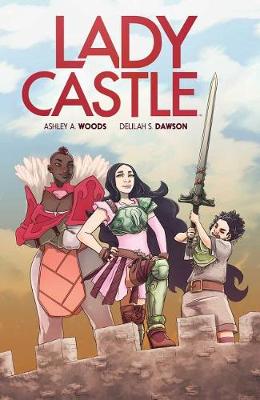Reviewed by nannah on
Representation:
The King of Ladycastle, King Merinor, is a black woman.
There are many diverse characters in the background, such as a disabled inventor, a muslim alchemist, etc.
When news reaches Mancastle that all of the men have died (except the messenger, of course), the kingdom drastically changes. For one, Princess Aeve is released from her tower, free from marrying anyone she doesn’t want to. Secondly, the blacksmith’s wife, Merinor, picks up a mysterious sword from the lake, which names her the new King of Mancastle -- promptly changed to Ladycastle. Lastly, all the women left behind have to deal with the curse the men have unleashed on them by refusing to pay a bridge toll -- which in turn angered the wizard that killed them all.
The concept sounds promising! And what I loved are the little tiny bits where these characters interact and really deal with the reality of their situation rather than the kind of silly spiffs or jokes on Disney songs, Arthurian themes, etc. (aka Princess/Knight Aeve talking to her little sister about loss and their father and how he may not have been the perfect man her little sister thinks he was, how King Merinor is actually terrified and doesn’t know what to do in every situation, etc.).
Unfortunately these moments were overshadowed by those silly jokes -- especially the beginning of every issue wherein Princess Aeve sings for about half each issue itself. Usually it’s recognizably a Disney princess song with different words about the situation they’re in (a harpy attack, a werewolf attack, etc.) set to, for example, “When Will My Life Begin?” from the movie Tangled. This leaves little page time for the development between characters and for the characters themselves that I craved.
I also wish there were more LGBT characters here. I know I seem to be asking a lot, since the graphic novel is already diverse, but in a kingdom of only “women” (except one), you’re telling me they’re all straight and cis? It also made me uncomfortable with all the Ladycastle vs Mancastle, women vs men, etc. It seemed very much like a simple white feminist story (if you know what I mean?), even with a black King.
Ah, I don’t want to be too critical, because it is a children’s graphic novel, and though very simple, I think kids will enjoy it. It has some good things going for it and some very sweet and lovely moments. However, I do believe there are better stories out there for this age group.
Edit:
Never mind, I just saw this was for young adult, and not middle grade. I think it’s much better suited to a younger audience. It works for middle grade; for YA I think you’d be better off skipping it.
Reading updates
- Started reading
- 3 February, 2020: Finished reading
- 3 February, 2020: Reviewed
